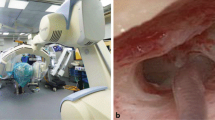Abstract
Purpose
Portable CT scanners are beneficial for diagnosis in the intensive care unit, emergency room, and operating room. Portable fixed-base versus translating-base CT systems were evaluated for otologic image-guided surgical (IGS) applications based on geometric accuracy and utility for percutaneous cochlear implantation.
Methods
Five cadaveric skulls were fitted with fiducial markers and scanned using both a translating-base, 8-slice CT scanner (CereTom®) and a fixed-base, flat-panel, volume CT (fpVCT) scanner (Xoran xCAT®). Images were analyzed for: (a) subjective quality (i.e., noise), (b) consistency of attenuation measurements (Hounsfield units) across similar tissue, and (c) geometric accuracy of fiducial marker positions. The utility of these scanners in clinical IGS cases was tested.
Results
Five cadaveric specimens were scanned using each of the scanners. The translating-base, 8-slice CT scanner had spatially consistent Hounsfield units, and the image quality was subjectively good. However, because of movement variations during scanning, the geometric accuracy of fiducial marker positions was low. The fixed-base, fpVCT system had high spatial resolution, but the images were noisy and had spatially inconsistent attenuation measurements, while the geometric representation of the fiducial markers was highly accurate.
Conclusion
Two types of portable CT scanners were evaluated for otologic IGS. The translating-base, 8-slice CT scanner provided better image quality than a fixed-base, fpVCT scanner. However, the inherent error in three-dimensional spatial relationships by the translating-based system makes it suboptimal for otologic IGS use.
Similar content being viewed by others
References
Schlaier J, Warnat J, Brawanski A (2002) Registration accuracy and practicability of laser-directed surface matching. Comput Aided Surg 7: 284–290
Maurer C, Fitpatrick J, Wang M et al (1997) Registration of head volume images using implantable fiducial markers. IEEE Trans Med Imaging 16: 447–462
Fitzpatrick JM (2010) The role of registration in accurate surgical guidance. J Eng Med 224(5): 607–622
House W (1982) Surgical considerations in cochlear implantation. Ann Otol Rhinol Laryngol Supp 91(2(Pt 3): 15–20
Su W, Marion MS, Hinojosa R, Matz GJ (1982) Anatomical measurements of the cochlear aqueduct, round window membrane, round window niche, and facial recess. Laryngoscope 92: 483–486
Labadie RF, Choudhury P, Cetinkaya E, Balachandran R, Haynes DS, Fenlon M, Juscyzk S, Fitzpatrick JM (2005) Minimally-invasive, image-guided, facial-recess approach to the middle ear: demonstration of the concept of percutaneous cochlear access in vitro. Otol Neurotol 26: 557–562
Warren FM, Balachandran R, Fitzpatrick JM, Labadie RF (2007) Percutaneous cochlear access using bone-mounted, customized drill guides: demonstration of concept in vitro. Otol Neurotol 28(3): 325–329
Labadie RF, Noble JH, Dawant BM, Balachandran R, Majdani O, Fitzpatrick JM (2008) Clinical validation of percutaneous cochlear implant surgery: initial report. Laryngoscope 118(6): 1031–1039
Labadie RF, Balachandran R, Mitchell J, Noble JH, Majdani O, Dawant BM, Bennett M, Haynes DS, Fitzpatrick JM (2010) Clinical validation study of percutaneous cochlear access using patient customized micro-stereotactic frames. Otol Neurotol 31(1): 94–99
Wang MY, Maurer CR Jr, Fitzpatrick JM, Maciunas RJ (1996) An automatic technique for finding and localizing externally attached markers in CT and MR volume images of the head. IEEE Trans Biomed Eng 43: 627–637
Noble JH, Dawant BM, Warren FM et al (2009) Automatic identification and 3D rendering of temporal bone anatomy. Otol Neurotol 30(4): 436–442
Noble JH, Warren FM, Labadie RF et al (2008) Automatic segmentation of the facial nerve and chorda tympani in CT images using spatially dependent feature values. Med Phys 35(12): 5375–5384
Noble JH, Warren FM, Labadie RF et al (2007) Determination of drill paths for percutaneous cochlear access accounting for target positioning error. Progress in Biomedical Optics and Imaging— Proceeding of SPIE, vol 6509, pp 650925.1–650925.10
Maes F, Collignon A, Vandermeulen D, Marchal G, Suetens P (1997) Multimodality image registration by maximization of mutual information. IEEE Trans Med Imaging 16: 187–198
Peace K, Wilensky EM, Frangos S, MacMurtrie E, Shields E, Hujcs M, Levine J, Kofke A, Yang W, Le Roux PD (2010) The use of a portable head CT scanner in the intensive care unit. J Neurosci Nurs 42(2): 109–116
Rumboldta Z, Hudaa W, Allb JW (2009) Review of portable CT with assessment of a dedicated head CT scanner. AJNR 30(9): 1630–1636
Weinreb DB, Stahl JE (2009) Portable CT imaging of acute stroke patients in the emergency department. Radiol Manage 31(2): 41–45
Das S, Maeso PA, Figueroa RE, Senior BA, Delgaudio JM, Sillers MJ, Schlosser RJ, Kountakis SE (2008) The use of portable intraoperative computed tomography scanning for real-time image guidance: a pilot cadaver study. Am J Rhinol 22(2): 166–169
Loubele M, Maes F, Jacobs R et al (2008) Comparative study of image quality for MSCTand CBCT scanners for dentomaxillofacial radiology applications. Radiat Prot Dosimetry 129: 222–226
Majdani O, Thews K, Bartling S, Leinung M, Dalchow C, Labadie R, Lenarz T, Heidrich G (2009) Temporal bone imaging: comparison of flat panel volume CT and multisection CT. AJNR 30(7): 1419–1424
Author information
Authors and Affiliations
Corresponding author
Rights and permissions
About this article
Cite this article
Balachandran, R., Schurzig, D., Fitzpatrick, J.M. et al. Evaluation of portable CT scanners for otologic image-guided surgery. Int J CARS 7, 315–321 (2012). https://doi.org/10.1007/s11548-011-0639-4
Received:
Accepted:
Published:
Issue Date:
DOI: https://doi.org/10.1007/s11548-011-0639-4




